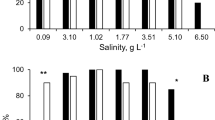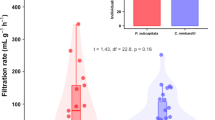Abstract
Field-measured grazing rates (ml/animal/d) of cladocerans (mostly daphniids) and diaptomids were assembled from various published studies and plotted as a function of corresponding phytoplankton concentration (µg l−1 f.w.). Filtering rates of both zooplankton groups initially increased with seston concentration until maximal grazing rates were observed at approximately 4 × 102 and 1 × 102 µg l−1 for cladocerans and copepods, respectively; at higher algal concentrations, filtering rates of both declined as a function of food concentration. The shape of these curves are most consistent with Holling's (1966) Type 3 functional response.
We found little support for the Type 3 functional response in published laboratory studies of Daphnia; most investigators report either a Type 1 or Type 2 response. The one study in which the Type 3 response was observed involved experiments where animals were acclimated at low food concentrations for 24 h, whereas those studies associated with response Types 1 or 2 had acclimation periods of only 1 to 3 h. We therefore assembled relevant data from the literature to examine the effect of acclimation period on the feeding rates of Daphnia at low food concentrations. In the absence of any acclimation, animals filtered at extremely low rates. After 2 h of acclimation, however, filtering rates increased 4 to 5-fold but declined again with longer durations; after > 70 h of pre-conditioning, filtering rates were almost as low as they had been with no acclimation.
We also found little support for the Type 3 functional response in published studies of copepods. The only study associated with a Type 3 response involved a marine copepod that had been subjected to a starvation period of 48 h; however, an analysis of the effects of acclimation period did not yield conclusive evidence that filtering rates of freshwater copepods (Diaptomus and Eudiaptomus) decrease significantly with acclimation duration.
The low filtering rates associated with long acclimation periods in laboratory experiments appears to be a direct result of animals becoming emaciated from prolonged exposure to low food concentrations, a situation which renders them incapable of high filtering rates. This may explain the Type 3 functional response for field cladocerans, since zooplankton in food-limiting situations are constantly exposed to low food concentrations, and would therefore have low body carbon and consequently less energy to filter-feed. We cannot, however, use this to explain the Type 3 response for field diaptomids, since copepods in the laboratory did not appear to lose body carbon even after 72 h of feeding at very low food levels, and there was inconclusive evidence that either Diaptomus or Eudiaptomus decrease their filtering rates with acclimation period.
Although Incipient Limiting Concentrations (ILC) for Daphnia ranged from 1 to 8.5 × 103 µg 1−1, more than half of these fell between 1 and 3 × 103 µg l−1, bracketing the value of 2.7 × 102 µg l−1 for field cladocerans. There was, however, a great deal of variation in reported maximum ingestion rates (MIR), maximum filtering rates (MFR) and ILC values for Daphnia magna. ILC values from the few laboratory studies of freshwater copepods ranged between 0.5 to 2.8 × 103 µg 1−1, and was higher than the ILC value of approximately 0.2 × 103 µg l−1 calculated for field populations of D. minutus. Generally, there was considerable agreement among laboratory studies regarding the shape of grazing-rate and ingestion-rate curves when data were converted to similar units and presented on standardized scales.
Similar content being viewed by others
References
Briand, F. & E. McCauley, 1978. Cybernetic mechanisms in lake plankton systems: how to control undesirable algae. Nature 273: 228–230.
Buckingham, S., 1978. Functional response and feeding strategies of freshwater filter-feeding zooplankton. Ph.D. thesis, University of British Columbia, Vancouver, 158 pp.
Burns, C. W., 1968. The relationship between body size of filtering Cladocera and the maximum particle ingested. Limnol. Oceanogr. 13: 675–678.
Burns, C. W. & F. H. Rigler, 1967. Comparison of filtering rates of Daphnia rosea in lake water and in suspensions of yeast. Limnol. Oceanogr. 12: 492–502.
Chow-Fraser, P., 1986a. The effect of handling and acclimation period on the grazing rate of Daphnia and Diaptomus. Hydrobiologia 137: 203–210.
Chow-Fraser, P., 1986b. An empirical model to predict in situ grazing rate of Diaptomus minutus Lilljeborg on small algal particles. Can. J. Fish. aquat. Sci. 43: 1065–1070.
Chow-Fraser, P. & R. Knoechel, 1985. Factors regulating in situ filtering rates of Cladocera. Can. J. Fish. aquat. Sci. 42: 567–576.
DeMott, W. R., 1982. Feeding selectivities and relative ingestion rates of Daphnia and Bosmina. Limnol. Oceanogr. 27: 518–527.
DeMott, W. R., 1986. The role of taste in food selection by freshwater zooplankton. Oecologia. 69: 334–340.
DeMott, W. R., 1989. Optimal foraging theory as a predictor of chemically mediated food selection by suspension-feeding copepods. Limnol. Oceanogr. 34: 140–154.
DeMott, W. R., 1990. Retention efficiency, perceptual bias, and active choice as mechanisms of food selection by suspension-feeding zooplankton. In: R. N. Hughes (ed) Behavioural Mechanisms of Food Selection. NATO ASI Series Vol G20: 569–594.
Frost, B. W., 1972. Effects of size and concentration of food particles on the feeding behavior of the marine planktonic copepod Calanus pacificus. Limnol. Oceanogr. 17: 805–815.
Frost, B. W., 1975. A threshold feeding behavior in Calanus pacificus. Limnol. Oceanogr. 20: 263–266.
Geller, W., 1975. Food ingestion of Daphnia pulex as a function of food concentration, temperature, animal's body length and hunger. Arch. Hydrobiol. Suppl. 48: 47–107.
Gliwicz, Z. M., 1969. Studies on the feeding of pelagic zooplankton in lakes with varying trophy. Ekol. Polska A 17: 664–709.
Gliwicz, Z. M., 1977. Food size selection and seasonal succession of filter feeding in an eutrophic lake. Ekol. Polska. 25: 179–225.
Gliwicz, Z. M., 1980. Filtering rates, food size selection, and feeding rates in cladocerans — another aspect of interspecific competition in filter-feeding zooplankton. ASLO Special Symposium 3: 282–291.
Gliwicz, Z. M., 1990. Food thresholds and body size in cladocerans. Nature 343: 638–640.
Gliwicz, Z. M. & W. Lampert, 1990. Food thresholds in Daphnia species in the absence and presence of blue-green filaments. Ecology 71: 691–702.
Haney, J. F., 1971. An in situ method for the measurement of zooplankton grazing rates. Limnol. Oceanogr. 16: 970–977.
Haney, J. F., 1985. Regulation of cladoceran filtering rates in nature by body size, food concentration, and diel feeding patterns. Limnol. Oceanogr. 30: 397–411.
Holling, C. W., 1959. Some characteristics of simple types of predation and parasitism. Can. Ent. 91: 385–398.
Holling, C. W., 1965. The functional response of predators to prey density and its role in mimicry and population regulation. Mem. Ent. Soc. Can. 45: 1–60.
Holling, C. W., 1966. The functional response of invertebrate predators to prey density. Mem. Ent. Soc. Can. 48: 1–86.
Horn, W., 1981. Phytoplankton losses due to zooplankton grazing in a drinking water reservoir. Int. Revue ges. Hydrobiol. 66: 787–810.
Kersting, K. & W. van der Leeuw, 1976. Use of the coulter counter for measuring the filtering rates of Daphnia magna. Hydrobiologia 49: 233–237.
Knoechel, R. & L. B. Holtby, 1986. Construction and validation of a body-length based model for the prediction of cladoceran community filtering rate. Limnol. Oceanogr. 31: 1–16.
Lam, R. K. & B. W. Frost, 1976. Model of copepod filtering response to changes in size and concentration of food. Limnol. Oceanogr. 21: 490–500.
Lampert, W., 1987. Feeding and Nutrition in Daphnia. In: R. H. Peter & R. de Bernardi (Eds) Daphnia. Mem. Ist. Ital. Idrobiol. 45: 143–192.
Lehman, J. R., 1976. The filter-feeder as an optimal forager, and the predicted shapes of feeding curves. Limnol. Oceanogr. 21: 501–516.
Lehman, J. R. & C. D. Sandgren, 1985. Species specific rates of growth and grazing loss among freshwater algae. Limnol. Oceanogr. 30: 34–46.
McMahon, J. W., 1965. Some physical factors influencing the feeding behavior of Daphnia magna Straus. Can. J. Zool. 43: 603–162.
McMahon, J. W. & F. H. Rigler, 1963. Mechanisms regulating the feeding rate of Daphnia magna Straus. Can. J. Zool. 41: 321–332.
McMahon, J. W. & F. H. Rigler, 1965. Feeding rate of Daphnia magna Straus in different foods labelled with radioactive phosphorus. Limnol. Oceanogr. 10: 105–113.
Muck, P. & W. Lampert, 1980. Feeding of freshwater filter-feeders at very low food concentrations. J. Plankton Res. 2: 367–379.
Muck, P. & W. Lampert, 1984. An experimental study on the importance of food conditions for the relative abundance of calanoid copepods and cladocerans. 1. Comparative feeding studies with Eudiaptomus gracilis and Daphnia longispina. Arch. Hydrobiol. Suppl. 66: 157–179.
Mullin, M. M., E. Fuglister-Stewart & F. J. Fuglister, 1975. Ingestion by planktonic grazers as a function of concentration of food. Limnol. Oceanogr. 20: 259–262.
Nalewajko, C., 1966. Dry weight, ash and volume data for some freshwater planktonic algae. J. Fish. Res. Bd Can. 27: 13–20.
Parsons, T. R., R. J. LeBrasseur & J. D. Fulton, 1967. Some observations on the dependence of zooplankton grazing on the cell size and concentration of phytoplankton blooms. J. Ocean. Soc. Jap. 23: 10–17.
Peters, R. H., 1984. Methods for the study of feeding, grazing and assimilation by zooplankton. In Downing, J. A. & F. H. Rigler (eds), ‘A manual on methods for the assessment of secondary productivity in fresh waters’, IBP Handbook 17 (2nd edition) Blackwell, Oxford: 336–412.
Peters, R. H. & J. A. Downing, 1984. Empirical analysis of zooplankton filtering and feeding rates. Limnol. Oceanogr. 29: 763–784.
Porter, K. G., 1973. Selective grazing and differential digestion of algae by zooplankton. Nature 244: 179–180.
Porter, K. G., J. Gerritsen & J. D. Orcutt. Jr., 1982. The effect of food concentration on swimming patterns, feeding behavior, ingestion, assimilation, and respiration by Daphnia. Limnol. Oceanogr. 27: 935–949.
Real, L., 1977. The Kinetics of functional response. Am. Nat. 111: 289–300.
Richman, S., 1964. Energy transformation studies on Diaptomus oregonensis. Verh. Int. Ver. Limnol. 15: 654–659.
Richman, S., 1966. The effect of phytoplankton concentration on the feeding rate of Diaptomus oregonensis. Verh. Int. Ver. Limnol. 116: 392–398.
Rigler, F. H., 1961. The relation between concentration of food and feeding rate of Daphnia magna Straus. Can. J. Zool. 39: 857–868.
Steele, J. H., 1974. The structure of marine ecosystems. Harvard University.
Vanderploeg, H., 1981. Seasonal particle-size selection by Diaptomus sicilis in offshore Lake Michigan. Can. J. Fish. aquat. Sci. 38: 504–517.
Vanderploeg, H., 1990. Feeding mechanisms and particle selection in suspension-feeding zooplankton. In R. S. Wotton (eds), The Biology of Particles in Aquatic Systems. Boca Ratton. CRC Press Inc.,: 184–212.
Vanderploeg, H., D. Scavia & J. R. Liebig, 1984. Feeding rate of Diaptomus sicilis and its relation to selectivity and effective food concentration in algal mixtures and in Lake Michigan. J. Plankton Res. 6: 919–942.
Vanderploeg, H. & G.-A. Paffenhöfer, 1985. Modes of algal capture by the freshwater copepod, Diaptomus sicilis and their relation to food-size selection. Limnol. Oceanogr. 30: 871–885.
Vanderploeg, H., G.-A. Paffenhöfer & J. R. Liebig, 1988. Diaptomus vs. net phytoplankton: effects of algal size and morphology on selectivity of a behaviourally flexible, omnivorous copepod. Bull. mar. Sci. 43: 377–394.
Vanderploeg, H., G.-A. Paffenhöfer & J. R. Liebig, 1990. Concentration-variable interactions between calanoid copepods and particles of different food quality: observations and hypotheses. In R. N. Hughes (ed) Behavioural Mechanisms of Food Selection. NATO ASI Series Vol. G20.: 595–613.
Vanni, M. J., 1987. Effects of food availability and fish predation on a zooplankton community. Ecol. Monogr. 57: 61–88.
Author information
Authors and Affiliations
Rights and permissions
About this article
Cite this article
Chow-Fraser, P., Sprules, W.G. Type-3 functional response in limnetic suspension-feeders, as demonstrated by in situ grazing rates. Hydrobiologia 232, 175–191 (1992). https://doi.org/10.1007/BF00013703
Received:
Revised:
Accepted:
Issue Date:
DOI: https://doi.org/10.1007/BF00013703




